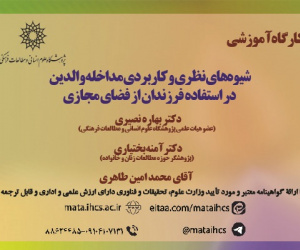نشانه شناسی اجتماعی تصویر مهاجرت در آثار عکاسان ایرانی «مطالعه موردی مجموعه عکس های صحنه آرایی شده سه عکاس ایرانی» (مقاله علمی وزارت علوم)
درجه علمی: نشریه علمی (وزارت علوم)
آرشیو
چکیده
موضوع مهاجرت در عکس، چه عکس های مردمی و چه در آثار عکاسان حرفه ای برخلاف ادبیات کمتر مورد بررسی قرار گرفته است، در این مقاله با رویکرد نشانه شناسی اجتماعی تصویر مجموعه عکس های صحنه آرایی شده سه عکاس ایرانی ( تبریزیان، مرادی و دشتی) بررسی شده است. و بر اساس الگوی استعاره عمیق جرالد زالتمن در تبلیغات که رهیافتی از استعاره های مفهومی لیکاف و جانسون در نظریه معاصر استعاره است، بازنمایی مفاهیمی چون وطن، هویت، فرهنگ و ... مورد واکاوی قرار می گیرد. سوال اصلی تحقیق اینست که برساخت عکاسان ایرانی از مساله مهاجرت چگونه است؟ و این استعاره ها با چه مولفه های بصری ترسیم شده است؟ نتایج تحقیق نشان می دهد خانه، طبیعت و جاده محوری ترین موضوعات بازنمایی شده از مهاجرت است. چهار استعاره عمیق سفر و ظرف، تحول و منبع بیانگر نگاه این عکاسان به موضوع مهاجرت است، در این عکسها استعاره عمیق سفر بیشتر بیانگر سفر درونی و ذهنی فرد مهاجر است، خانه و فضای خانه که بیشتر تهی از روابط خانوادگی مجسم شده است چون ظرفی خاطرات و رویاهای فرد مهاجر را در برمیگیرد. در عکسهای مرادی مهاجرت با تحول بیرونی و درونی نشان داده شده در واقع تحول هویت فرد مهاجر و فرایند شدن به تصویر کشیده شده است. در مجموعه گوهر دشتی نیز طبیعت به عنوان منبعی ازلی جانشین وطن می شود. نوع بازنمایی طبیعت به مثابه چشم اندازی متعالی بیانگر آنست که این منبع گنجایش آن را دارد تا فرد مهاجر، خاطرات، روابط، مرگ و زندگی و عشق، مادر را در برگیرد.Social semiotics of the image of migration in the photos of Iranian photographers "A case study of the collection of staged photos of three Iranian photographers"
By a social semiotics framework, this article examines the staged photography collection of three Iranian photographers (Tabrizian, Moradi, and Dashti). Drawing inspiration from the Zaltman Metaphor Elicitation Technique (ZMET) in advertising, which builds upon Lakoff and Johnson's conceptual metaphors in contemporary metaphor theory, the study delves into conceptual representations such as homeland, identity, and culture. The primary research inquiry revolves around how Iranian photographers construct the concept of migration and how these metaphors are visually depicted. The findings reveal that the central themes in the representation of migration are home, nature, and the road. The photographers' perspectives on migration are reflected through four overarching metaphors: journey and vessel, transformation, and source. The photographs primarily convey the profound metaphor of the journey, symbolizing the inner and mental voyage of the migrant individual. Home and its spatial representation as an emptying vessel for familial connections encapsulate the reservoir of memories and aspirations of the migrant individual. In Moradi's photographs, migration is portrayed through external and internal transformations, illustrating the evolution of the migrant's identity. Gohar Dashti's collection portrays nature as a timeless substitute for the homeland, with its representation as a sublime panorama suggesting its ability to encompass the migrant's memories, relationships, life, death, and love.











